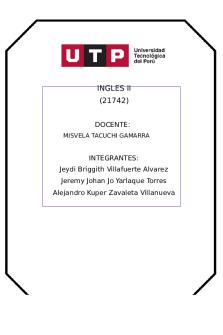Synthesis of the cases assigned for Week 6 PDF

| Title | Synthesis of the cases assigned for Week 6 |
|---|---|
| Course | LAW |
| Institution | Ateneo de Naga University |
| Pages | 2 |
| File Size | 39.7 KB |
| File Type | |
| Total Downloads | 413 |
| Total Views | 442 |
Summary
Synthesis of the cases assigned for Weeks 6The cases assigned for weeks six tackle the topic on treaties. The cases discuss the different important points that must be considered about treaties and other types of agreements entered into by the Philippines with other states. The creation of treaties,...
Description
Synthesis of the cases assigned for Weeks 6 The cases assigned for weeks six tackle the topic on treaties. The cases discuss the different important points that must be considered about treaties and other types of agreements entered into by the Philippines with other states. The creation of treaties, their application and their difference as to other international agreements were illustrated in the case. The first case, Abaya vs. Ebdane, assigned talked about a loan agreement between the Philippines and a foreign bank wherein it was established that the loan agreement is considered as an executive agreement that binds the Philippines to follow the agreement pursuant to the fundamental principle of pacta sunt servanda, despite a local law being contrary to some stipulations of the agreement. In the case, the petitioners argued that the since the foreign bank was not a sovereign entity, the loan agreement could not be considered as a treaty or international agreement since it is stated that these are supposed to be entered into by two sovereign nations. However, the court ruled that the loan agreement was entered into in light of the exchange of notes that the Philippines government had with the government of Japan. Thus, this case shows that although the loan agreement was between the country and a bank, but since the cause of such agreement was done due to exchange of notes, such is considered as an executive agreement. The second case enunciated the definition of a treaty according to Article 2 (1) of the Vienna Convention on the Law of Treaties (Vienna Convention) which states that a treaty is “an international agreement concluded between States in written form and governed by international law, whether embodied in a single instrument or in two or more related instruments and whatever its particular designation.” Consequently, in the case of China National Machinery vs. Santamaria, it stated that the contracts entered into by a government owned and controlled corporation and a corporation of a sovereign country may not be considered as an executive agreement or treaty under international law. Unlike in the first case, the contract here was entered into by the entities in a separate personality distinct from that of the state. Both entities were not acting as a representative of the state, hence the contract was not entered into by two states that could qualify it to be considered as a treaty, as required by the Vienna Convention on the Law of treaties. The case of Lim vs. Executive Secretary discussed how a treaty can be interpreted when there may be ambiguity as to the terms found in the treaty. The court used the rule laid down in Article 31 sec 3 and Article 32 of the
Vienna Convention on the Law of Treaties, wherein it stated that interpretation of the stipulations would be through examining the text in order to ascertain the intention of the contracting states and also to use other supplemental elements. Further, an important rule as to complying with treaties was also mentioned in this case, which was that once a country has entered into a treaty, they are bound to follow such and is not allowed to “invoke the provisions of its internal law as justification for its failure to perform a treaty.” Also related to the definition under the Vienna Convention of a treaty, is the case of Bayan vs. Zamora. The court stated that a treaty and an executive agreement are similar as to the requisites which are laid down in the Vienna Convention on the Law of Treaties. An executive agreement must also (a) be an agreement between states; (b) be in writing; and (c) be governed by international law. The difference as to the two lies in how it becomes effective in the Philippines. Treaties require concurrence of the Senate while Executive agreements do not. Although when it comes to international law, as stated in the case, “there is no difference between treaties and executive agreements in their binding effect upon states concerned, as long as the negotiating functionaries have remained within their powers.” Moreover, another important point mentioned was that ratification of treaties is an executive act and the role of the senate is merely for concurrence. The last case assigned, Reservations to the Convention on Genocide Case, deals with reservations made as to treaties entered into. It was cited that countries who enter into a treaty may state their reservations despite them being signatories to the treaty. This is applicable so long as the treaty is a multilateral treaty and that the reservations made do not defeat the purpose of the treaty itself. All reservations are to be assessed and examined to see if such may be allowed and are not contrary to the purpose of the treaty. The cases assigned show that treaties are guided by the rules set out by the Vienna Convention, from their creation to their application. Also, the most important thing about treaties is that they are binding to the states that enter to it and thus make these states obligated to follow all the agreements in good faith. Hence, it strengthens the point that international law is indeed law since the states consent to them being so....
Similar Free PDFs

The synthesis of Ibuprofen
- 4 Pages

Title The Synthesis of Alum
- 2 Pages

Week 1 Cases
- 5 Pages

Week 6 Week 6 Week 6Week 6
- 2 Pages

HW for Week 6 - homework
- 3 Pages

Week 6 - Task - The family
- 6 Pages

Week 6 ingles Week 6
- 2 Pages
Popular Institutions
- Tinajero National High School - Annex
- Politeknik Caltex Riau
- Yokohama City University
- SGT University
- University of Al-Qadisiyah
- Divine Word College of Vigan
- Techniek College Rotterdam
- Universidade de Santiago
- Universiti Teknologi MARA Cawangan Johor Kampus Pasir Gudang
- Poltekkes Kemenkes Yogyakarta
- Baguio City National High School
- Colegio san marcos
- preparatoria uno
- Centro de Bachillerato Tecnológico Industrial y de Servicios No. 107
- Dalian Maritime University
- Quang Trung Secondary School
- Colegio Tecnológico en Informática
- Corporación Regional de Educación Superior
- Grupo CEDVA
- Dar Al Uloom University
- Centro de Estudios Preuniversitarios de la Universidad Nacional de Ingeniería
- 上智大学
- Aakash International School, Nuna Majara
- San Felipe Neri Catholic School
- Kang Chiao International School - New Taipei City
- Misamis Occidental National High School
- Institución Educativa Escuela Normal Juan Ladrilleros
- Kolehiyo ng Pantukan
- Batanes State College
- Instituto Continental
- Sekolah Menengah Kejuruan Kesehatan Kaltara (Tarakan)
- Colegio de La Inmaculada Concepcion - Cebu








